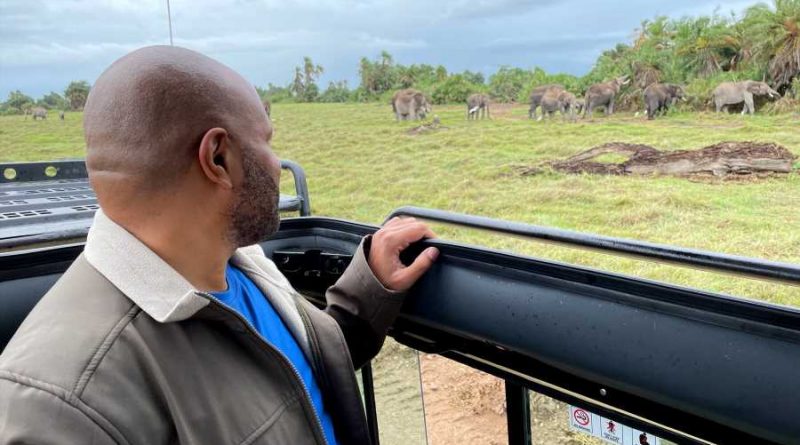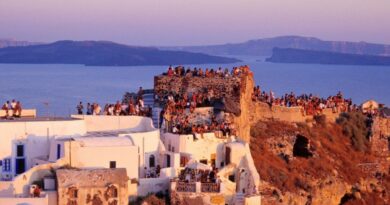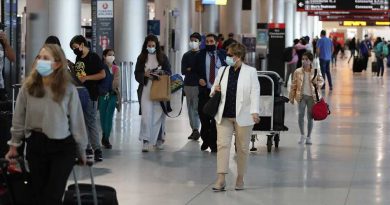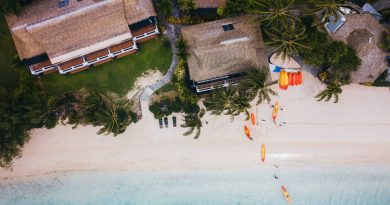A Black American Traveler Shares His Experience of Visiting Africa for the First Time
In terms of African travel destinations, Morocco and Egypt were the only two that topped my must-see list for a long a time. But that recently changed following my first trip to Kenya. First, I should explain that I have a direct connection to Africa. My mother married my stepfather, who is from Freetown, Sierra Leone, and two of my siblings were born and raised there, too. However, my close connection with them still did not spark any desire to visit what some African Americans call the “Motherland.”
At 15 years old, an only child to a single parent, I instantly became a part of a blended family. And the blending of two different cultures — Black American and African — made the transition more difficult. From an early age, my personal experiences gradually formed my opinions about Africa. Throughout my life, I’d heard side conversations among friends and other Black Americans who felt, “Some Africans think they’re better than us.” And as a teenager, my stepfather would point out that I was American when introduced to African friends, which felt like a social handicap. But in time, I learned to embrace my new family and grew secure in myself as a Black man.
A Trip of a Lifetime
It wasn’t until November 2020 that Africa shifted as a priority destination. A colleague asked if I was interested in traveling to Kenya for a 10-day safari. Part of my motivation to go was hearing a close friend rave about his amazing experience on safari in Kenya and Tanzania a few years ago. This trip also appealed to me because it combined luxury travel, adventure, the outdoors, and culture — all key elements I enjoy about traveling.
Three weeks later, I was off to Kenya to stay at three Elewana properties — Tortilis Camp Amboseli, Kifaru House Lewa, and Sand River Masai Mara — and go on safari in three different parks and reserves to see the Big Five. In addition to wildlife encounters, visiting a Maasai village was at the top of my list. I wanted to witness the famous adumu, the traditional jumping dance associated with a Maasai warrior rite of passage. An immersive adventure to see animals and connect with the indigenous people in Kenya sounded like a trip of a lifetime — and it was.
A Warm Welcome
As soon as I stepped off the plane in Nairobi, I could already sense a difference. It was only two weeks ago that I experienced racial profiling at the Velana International Airport in Male, Maldives. Noticeably, most people pulled aside for the random bag check were people of color. My arrival at Jomo Kenyatta International Airport, however, was quite different. I wasn’t profiled, though customs officials were rightfully strict in ensuring every traveler had their passport, e-visa, health declaration form, and negative COVID-19 test results.
As I checked in with a customs officer, she quickly informed me that I’d have to speak to her supervisor, as I had mistakenly applied for the East Africa Tourist Visa, which would allow me to visit not only Kenya, but two other African countries, too.
“If you want to stay in Africa for three to four months, you can also visit Rwanda and Uganda with your visa,” the customs supervisor said with a warm smile. I responded, “Wow, I can kill three birds with one stone.” She smiled and laughed.
It wasn’t a deep conversation, but it was simple interactions with Kenyans on a daily basis that made me feel like I belonged there, and that I was genuinely welcome. It’s a sharp contrast to some places where customs officials have greeted me with a scowl and questions regarding my intentions while traveling.
Video: Baby elephant slips next to tourists in South Africa (BuzzVideos)
Goats get rammed by hungry calf
BuzzVideos
Locust plague swarm in Indian city
BuzzVideos
Cat tries to catch some steam
BuzzVideos
Cat can't control his tongue
BuzzVideos
Pony gives owner a lift
BuzzVideos
Woman thinks wedding proposal is a prank
BuzzVideos
This dog hates taking selfies with his owner
BuzzVideos
The craziest last minute of a soccer match
BuzzVideos
Trapeze artists perform amazing feat
BuzzVideos
Mom goes crazy when she finds out her daughter got in to NYU Film School
BuzzVideos
Bear tries get into car in Tennessee
BuzzVideos
This guy takes a big risk to film a frozen lake
BuzzVideos
This dog has the longest tongue in the world
BuzzVideos
Barber shop tutorial went wrong
BuzzVideos
Octopus' predatory moves in tide pool
BuzzVideos
This camel loves to chew on his owner's hair
BuzzVideos
Goats get rammed by hungry calf
Blocking the path of a hungry calf is never a good idea! As several small goats grazed peacefully on this farm at Travelers Rest, South Carolina, a baby cow didn't think twice about ramming the herd as if they were bowling pins.
BuzzVideos
Locust plague swarm in Indian city
The city of Bophal, India, was invaded by a locust plague that covered the entire region. While these insects are not dangerous as such, they can be very annoying. Bhawna Dwivedi captured the bizarre scene from his window.
BuzzVideos
Cat tries to catch some steam
This British Shorthair feline was totally confused by the humidifier that his owner switched on. The cat tried to catch the steam and stop it coming out of the machine with his paws.
BuzzVideos
Related: Get to Know Jessica Nabongo, the First Documented Black Woman to Travel to Every Country in the World
Connecting With the Maasai People
Traveling to Kenya gave me the opportunity to see wildlife roaming in lush green grasslands, with Mount Kilimanjaro or Mount Kenya adding to the picturesque backdrop. The landscape at Amboseli National Park, Lewa Wildlife Conservancy, and the Maasai Mara National Reserve was nothing short of a modern-day Garden of Eden. And seeing leopards, cheetahs, lions, elephants, giraffes, rhinos, zebras, and dozens of other animals firsthand in their natural habitat was incredible.
During the morning and evening game drives, Kenya’s landscape resembled an exquisite oil painting, even when a storm was brewing in the distance along the horizon. Spending time talking to our tour guides was just as important. It not only offered an opportunity to understand the behaviors of each animal we spotted, but it was also a chance to have candid conversations with locals who were able to provide firsthand accounts of life in Nairobi or a Maasai village.
Related: 10 Mistakes to Avoid on a Safari, According to Experts
Connecting with locals has always been an essential part of travel, and 35-year-old tour guide Olekinyaga Polonet was one of those important connections. Polonet, also known by his English name, Godfried, is a husband and father of four children — two girls and two boys. His dreams and desires for his family are similar to many fathers. Chatting with him, I learned about his role as a Maasai young elder, as well as how some traditional Maasai villages still maintain their distance from modern society, while other communities embrace some simple technology, like email access.
Unlike other indigenous tribes in Kenya, the Maasai are nomadic cattle and goat herders who live off the land. Several Americans can probably identify with life on a farm — I certainly could. As a child, I spent a lot of time with my great grandparents, who owned land and a farm. The majority of what was on the kitchen table came from their garden or from the livestock they owned. So, living off the land wasn’t new to me. Farming was and still continues to be common way of life for a lot of Black families in the South.
Living off the land requires the Maasai people to move wherever their herd of goats or cattle can graze. This usually means living in remote areas, which has its positive aspects. Talking to Polonet and other Maasai men, I learned that their distance from mainstream Kenyan communities has created a buffer for them during the pandemic. Currently, there are no known coronavirus cases, according to Polonet. But the Maasai are fully aware of the virus because of their direct contact with local safari lodges and camps. So, it’s not uncommon to see them with face masks to help prevent the spread of the virus to their villages.
Because of the pandemic, tourists are no longer allowed to visit Maasai villages. But Meoli, the 33-year-old son of the Maasai chief, shared his insights on his tribe’s traditions and customs to my tour group during our stay at the Elewana Tortilis Camp. One custom he mentioned was the circumcision ceremony. This coming-of-age tradition for Maasai boys (12 to 25 years of age) requires them to sit silently through the procedure, and if they blink, gasp, or scream in pain, they will become an outcast to the tribe. Meoli said most boys make it through the ceremony, which is also part of the process of becoming a Maasai warrior.
Signs of Colonialism
The Maasai are steadfast in holding on to their traditions, but they have not escaped all contact with the outside world. More than 80% of Kenya’s total population is Christian, and Meoli identified himself as such. Meanwhile, Polonet said he learned to speak English while attending a missionary school. So, it’s not uncommon to see tour guides and hotel and safari camp employees wearing name tags that tout their post-baptism English name. (To be clear, I asked for the birth names of the people mentioned in this article.)
Some people changed their names to make it easier for tourists to pronounce. As a travel colleague pointed out, not allowing them to use their given name is “erasing their identity.” It’s not clear whether this is a company mandate or an individual preference, but if not the latter, I see it as a way of marginalizing African people and their culture. Why is it necessary to make names easy for tourists? It’s a question that begs to be answered.
Saying so Long to Africa for Now
My journey through Kenya ignited my desire to visit other African countries, including Senegal, Tanzania, South Africa, and Sierra Leone. Kenya was a great gateway country to begin exploring more of the continent. As far as safaris go, a few of my well-traveled companions on this 10-day adventure told me that starting out with Kenya sets the bar high.
Feeding pellets to Rothschild giraffes, adopting and meeting an orphaned baby elephant, and riding in a hot air balloon at sunrise were all unforgettable experiences. My first trip to Kenya and Africa was full of unexpected excursions and upscale camping accommodations, but I made it a priority to talk to the locals and understand what everyday life is like for them. This trip was transformative. Kenya provided me with an opportunity to learn more about Africa, so that one day, I will be able to immerse myself among the people and cultures where my ancestors once lived. That day will come.
Source: Read Full Article





















